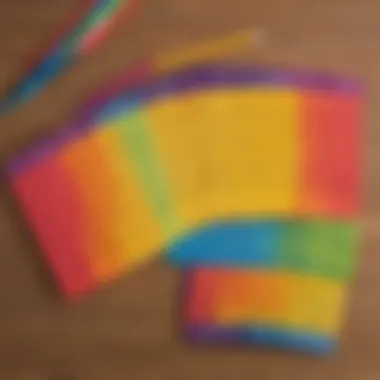Engaging Times Table Practice Methods for 3rd Graders


Intro
Mastering times tables is a fundamental skill for 3rd graders as it lays the groundwork for more advanced mathematical concepts. This age is crucial for children, since they start to encounter more complex math challenges. Fluency in multiplication builds confidence and allows for success in future studies. To assist kids' learning, effective practices, resources, and engaging activities are necessary.
In the following sections, we’ll explore strategies that encompass hands-on learning, digital resources, and traditional methods. These various approaches aim to cater to different learning styles, allowing children to engage with the material practically.
Interactive Learning Games
Learning math can be enjoyable and exciting, especially with interactive games. These games grab kids' attention and keep them engaged, making multiplication practice feel less like a chore.
Popular Games
Among the standout games, tools like Buzz Math, Super Simple Games, and Multiplication.com are notable. These resources focus on providing challenges that make kids think while imparting multiplication skills. They have become favorites among teachers and parents alike.
Description of top educational games
These games vary from simple addition of values, to stimulating competitive elements that encourage fast thinking. For example, Buzz Math enhances logic skills, while Super Simple provides a color-filled, vibrant experience that is fun to use.
Benefits of playing educational games for kids' cognitive development
Games are not only for entertainment; they also strengthen cognitive connections. Engaging through gameplay enhances problem-solving abilities. Kids practice multiplication yet enjoy every minute. Through play, they often improve hand-eye coordination and fine motor skills. As a result, educational games promote a comprehensive approach to learning.
Game Reviews
Research shows that some games can lead to more effective learning outcomes. For instance, Buzz Math tends to be praised for its comprehensive curriculum approach, where children engage with multiplication problems dynamically.
Comparison of gameplay and learning outcomes
Comparing players’ experiences provides valuable insight. Users often highlight the differences in engagement levels, contextual settings, and settings where math skills get reinforced.
Tips and Tricks
There are ways to enhance the learning experience for kids.
Practical tips for parents and educators to enhance children's learning journey
- Make it routine. Regular practice helps reinforce learning.
- Keep it diverse. Vary the activities to keep engagement high.
- Incorporate rewards. Recognizing effort promotes motivation.
Strategies for making learning fun and engaging
These varies strategies are useful.
- Use a mix of media, like books and videos, to appeal visually and audibly.
- Encourage friendly competitions, such as timed tests or group activities.
- Emphasize real-world applications to make multiplication seem vital in everyday life.
Creative DIY Projects
Hands-on experience is proven to solidify learning. Engaging in DIY projects helps to develop practical skills while enabling creative expression and math mastery.
Step-by-Step Guides
This DIY practice boosts creativity. Instructions should be clear and age suitable for them. For instance, materials may include papers or household items to aid the actual crafting process. Fostering these choices nurtures both cognitive and practical skills.
Craft Ideas
Here are ideas you can encourage:
- Multiplication flashcards made from index cards.
- Dice games that incorporate various math problems.
- Number collages that illustrate multiplication facts visually.
Preamble to Times Tables
Times tables serve as a foundation for understanding multiplication, which is a crucial component in a child's mathematical education. For third graders, grasping these concepts not only bolsters their confidence but also equips them with the skills needed for more advanced calculations later on. In this article, we explore why familiarity with multiplication tables is essential and present effective methods for practicing them.
Understanding Multiplication
At its core, multiplication is simply a way of making repeated additions. It allows us to compactly represent numerous additions in a single equation. For example, instead of saying 2 + 2 + 2, we can say 3 × 2. This simplification is powerful, especially as numbers grow larger.
Multiplication tables, or times tables, are structured sets of answers to such equations. Children start to learn these as early as in the second grade and continue to develop this knowledge further in third grade. Understanding these relationships forms the groundwork for future learning in more complex topics of mathematics.


Teaching multiplication through structured approaches involves clear conceptual frameworks. Young learners can navigate rather difficult calculations with practice and positive reinforcement. However, learning requires more than just drill work; recognizing the factors and products flexibly opens doors for deeper comprehension.
Significance for 3rd Graders
For third graders, mastering times tables comes with varied importance. Developing these skills affects both performance in class and confidence levels in numbers.
- Foundation for Advanced Math Skills: Times tables serve as a preliminary step to more profound mathematical concepts such as fractions, decimals, and algebra. Children rely on their multiplication skills far beyond elementary school math.
- Promotes Mental Math: Fluency in multiplication encourages stronger mental math capabilities. Fast recall creates efficiency and can enhance performance during tests or day-to-day mathematical challenges that children may encounter.
- Engaging and Fun Techniques: Practical exercises and games draw attention to students and encourage a positive attitude towards math. This approach can lead to success that builds higher self-esteem when problem-solving.
Remember, a positive association with math and multiplication through engaging methods encourages a lifelong appreciation for learning mathematics and its applications.
Foundational Concepts
Understanding foundational concepts in multiplication is essential for 3rd graders. This segment will explain the core elements that will help students build their times table skills effectively. Mastering these concepts sets a solid ground for more advanced math learning in later grades.
Basic Multiplication Definitions
Multiplication is essentially repeated addition. For example, when multiplying 3 by 4, you are adding 3 together four timess: 3 + 3 + 3 + 3. It helps children comprehend how multiplication works fundamentally.
In 3rd grade, it’s common to learn about factors and products. A factor is a number that is multiplied by another number to get a product. Knowing these definitions helps students grasp what is actually happening during multiplication.
Developing these definitions can significantly enhance understanding. Children often benefit from writing these definitions down in their math journals. Visual memory works well alongside written words.
Relation to Addition
Recognizing the connection between addition and multiplication is crucial. Children are familiar with addition from early education. When they discover that multiplication is an extension of addition, it can clear up confusion.
For instance, demonstrating that 5 multiplied by 2 is the same as adding 5 two times can help solidify the relationship: 5 x 2 = 5 + 5. Encouraging students to think of problems in this manner can improve their confidence.
Teachers might employ activities such as grouping objects. For example, placing five apples in each of two baskets visualizes the concept: 2 groups of 5 apples each become beneficial for deeper comprehension.
Visualizing Multiplication
Visual representation makes multiplication more tangible. Various tools can help kids foam visual images of multiplication concepts. Examples include arrays, number lines, and charts.
An array shows how groups combine into a larger set visually. For example, 3 rows of 4 dots can help communicate that 3 multiplied by 4 equals 12, where 12 is the total of dots in those rows.
Using interactive materials, such as blocks or counters, can foster understanding. Manipulatives are particularly effective for illustrating multiplication problems. Children can manipulate physical objects, ultimately solidifying their conceptual awareness.
Understanding foundational concepts helps textile a smooth journey into multiplication, eases complexities, and empowers students in math.
Methods for Practicing Times Tables
Practicing times tables is vital for 3rd graders as it builds a robust foundation in mathematics. Children at this age are starting to understand multiplication beyond just memorization. They are developing cognitive skills that will support their future learning. Effective methods of practice foster not just retention but also comprehension of multiplication. Incorporating a variety of techniques keeps engagement high and learning effective.
Traditional Flashcards
Traditional flashcards were a key tool for learning multiplication. They present multiplication facts in an easily digestible format. Each card displays a problem on one side, and the answer on the other. This method helps children with active recall, strengthening their memory. The repetitive nature of using flashcards makes them ideal for practice.
When using flashcards, parents can engage with their children. It can transform studying from a solitary task into a collaborative learning experience. Flashcards can also be tailored. For example, creating personalized cards with specific problem areas can help address individual stuggles. Regular practice sessions with flashcards enable children to see their progress over time.
Pros of Using Flashcards:
- Portable and easy to use anywhere
- Tailorable to child's specific needs
- Promotes active engagement
- Instills a systematic approach to learning
Considerations:
- The novelty of format may wear off; variations like timed drills can help
- Ensure a mixture of difficulty levels to keep the child challenged
Interactive Online Games
The rise of technology opens avenues for reinforcing multiplication through interactive online games. These platforms engage children instead of the traditional textbook method. Online games provide immediate feedback. For example, a game like Multiplication.com challenges children with time limits, boosting quick thinking skills while they practice.
In addition to speed, many online resources adopt a wide variety of formats like puzzles and quizzes to keep content fresh. Interactive games can motivate children by integrating rewards and more visualized representation of success. Regular interaction with math games can maintain interest and even improve hand-eye coordination.
Benefits of Online Games:
- Tons of resources accessible for various skill levels
- Encourages independent practice, building self-reliance
- Some games can foster competition, motivating further practice


Important Points:
- Always ensure that the content is suitable for the age group
- Mix digital with traditional to balance screen time
Hands-On Activities with Manipulatives
Using manipulatives is a worthwhile approach to practice times tables. These can include objects like blocks, counters, or even organic items like fruits. Manipulators bring a tactile element to learning math. By physically interacting with items, children can visualize multiplication as grouping rather than memorization alone. For example, they can practice 3 x 4 by organizing four groups of 3 blocks each.
Hands-on activities accommodate different learning styles. Some children grasp concepts faster through movement and interaction than by merely reading about them. This can introduce a playful element, encouraging them to explore multiplication in a less structured environment.
How to Use Activities:
- Set up challenges to solve specific multiplication problems using manipulative items
- Enable a storytelling exercise with the objects to echo real-world scenarios
- Encourage children to create their multiplication problems using available objects, enhancing both creativity and learning
Key Takeaways:
- Provides decipherable context for abstract concepts
- Engages varied learning styles for rich educational experience
- Encourages cooperative learning—great for groups and peer reviews
Using diverse methods for practicing times tables addresses various learning preferences and keeps children interested in improving their multiplication skills. The goal is to cultivate a solid understanding and applicability of mathematics in daily life.
Employing a mix of flashcards, online games, and hands-on activities gives kids the tools they need. With adaptable structures, families can create a flexible, enjoyable learning environment.
Integrating Times Table Practice into Daily Life
Integrating times table practice into daily life is crucial for reinforcing mathematical skills in children. It transforms abstract math concepts into familiar scenarios, making learning more meaningful. By embedding multiplicative reasoning into day-to-day activities, children can develop fluency in times tables without excessive pressure. This approach is beneficial for building stronger mathematical foundations that will serve them well in future academic pursuits.
Using Real-Life Situations
Real-life situations provide an ideal context for practicing times tables. We can utilize everyday scenarios to teach concepts of multiplication. Simple tasks, like cooking or shopping, are rich with opportunities. For instance, while grocery shopping, a parent can ask questions like, "If we buy four bags of apples, and each bag contains six apples, how many apples do we have in total?" This encourages children to think multiplication should be practical.
Engaging in tasks at home, such as setting the table, can also offer learning moments. The child can count how many plates are needed for a specific number of family members and various courses. This kind of problem-solving promotes both critical thinking and multipliying.
Families can add an educational twist to family outings or visits. When visiting a pizza place, for example, a child might compute the total number of slices from the number of pizzas and slices per pizza. Lastly, creating a loose structure where you reinforce the times table during these interactions ensures a casual, low-pressure atmosphere, which is key for motivation and zest for math.
Creating a Times Table Routine
Establishing a times table routine can greatly assist in mollifying the learning experience. Consistency is important, so a dedicated daily time should be set aside. For example, after school for around twenty minutes each day can be effective. The structure of the simplicity helps children know what to anticipate, fostering madd learning and mastery.
Routines may also include mix of activities. For instance:
- Learning through games adds enjoyment and variety.
- Repetition through speaking out or auditory drills.
- Use of visual supports like laminated card with learning outcomes.
Celebrating small milestones within these routines is commonly significant for self-esteem and can enhance motivation. Young learners could be reviewed at the end of each week to track their improvement, practicing individual facts or blocked sections. When adjustments are needed, they become manifestations of their learning journey rather than rote exercises when combined positively as an engagingbenou experience.
The closed loop of routine and encouragement carries weight with children. Recognizing their hard work reminds them that mastery is a gradual process, helping build confidence and spark curiosity for future mathematical study.
Utilizing Technology for Learning
In the current educational landscape, technology is essential for effective learning. Utilizing tools that embrace technology can reshape how 3rd graders interact with times tables. This exposure not only makes learning enjoyable but also fosters a deeper understanding of multiplication concepts. The importance of integrating technology lies in its ability to customize the learning experience based on a child's needs. Access to online resources opens various pathways to understanding mathematics, inspiring educators and students alike.
Educational Apps and Resources
A plethora of educational apps dedicate themselves to helping kids master their times tables. Applications such as Khan Academy Kids and Prodigy Math offer interactive, engaging activities tailored to various skill levels. They use gamification to turn practice sessions into fun challenges, unlocking intrinsic motivation in children. Each app typically includes features that track progress, ensuring parents and teachers are aware of the student's development. Incorporating these apps can significantly enhance worksheet-heavy learning with dynamic, visual elements that are more appealing to young minds.
- Examples of Effective Apps:
- Khan Academy Kids - Focuses on building foundational skills in a playful manner.
- Prodigy Math - Offers math challenges structured like a game, aligning with curriculum requirements.
- Times Tables Challenge - A simple interface with timed quizzes catering to various multiplication facts.
These resources are not merely supplemental; they offer a wide range of adaptive learning experiences that can fit various learning speeds directly, taking the stress off traditional rote memory methods.
Online Forums and Study Groups
Collaboration is another key element where technology shines in learning times tables. Online forums and study groups provide platforms for students and parents to engage with peers and educators. Websites such as Reddit have communities focused on educational topics, where ideas can be shared and teaching methods discussed. For example, parents can take part in discussions about experiences with specific apps or share study schedules that have proven successful.
Additionally, forming virtual study groups creates a sense of community among learners. With tools like Zoom or Google Meet, effectve study sessions can happen from the comfort of home. Students work together to reinforce learned concepts, practicing multiplication through group games.
- Benefits of Study Groups:


- Emotional support in overcoming learning challenges.
- Opportunity for cross-learning, where stronger students help others.
- Interaction allows sharing of new methods or strategies.
Assessing Progress
Assessing progress in mastering times tables is crucial for 3rd graders. It not only gives insight into a child’s understanding but also allows for refining teaching strategies and identifying areas that need improvement. When children are learning multiplication, regular evaluation makes it easier to see how they are progressing, and educators and parents can custom-tailor their approach to support effective learning.
Understanding a student's improvement over time can motivate both children and instructors. Celebrating small achievements in memorizing times tables can build confidence. At the same time, recognizing struggles can help create a directed plan of action, ensuring that efforts to teach these essential skills remain productive. Consequently, assessing progress can serve as a benchmark for setting realistic goals.
Monitoring Improvement
Monitoring improvement entails frequent checks on a child's understanding and retention of multiplication facts. Utilizing quizzes or timed tests provides immediate feedback on their performance. Setting up these informal assessments can highlight a few key aspects:
- Consistency is Key: Regular practice in various formats like oral quizzes or written tests promotes gradual improvement.
- Capture Data: Keep a log of scores to track progress over time. This can illustrate overall trends in understanding.
- Adjustments: If a child shows stagnation in learning, it might signify a need to modify their study habits or activities.
Parents might explore specific tools designed for tracking learning outcomes, such as printed worksheets or digital apps that monitor achievements and areas needing further exposure. Obviously, curated feedback is important to support motivation and education.
Identifying Areas of Difficulty
Identifying difficulty within times tables can be done through targeted analysis of assessment results. If specific multiplication facts prove problematic, either through patterns in incorrect answers or resistance in practice, it becomes necessary to adjust the learning approach.
To effectively pinpoint areas that need additional focus:
- Review Frequently Incorrect Facts: Note down which times tables cause consistent issues. It can help shed light on misconceptions.
- Note Individual Challenges: Some children may have difficulties due to abstract thinking; therefore, visual aids could be more beneficial for them.
- Engagement Levels: Understand the child’s engagement. If they show less enthusiasm for higher facts such as 8s or 9s, motivational strategies might be needed to reignite their interest.
Periodically checking in is fundamental, as it informs a better-tuned learning environment. Success in therein can help to bolster aspirations in math overall.
By embacing formal and informal methods, educators can present opportunities for children to evolve in their mathematical comprehension, vastly partnering with their ongoing experience.
Encouraging a Positive Attitude Towards Mathematics
A positive attitude towards mathematics is vital for children's success, especially in developing fluency in times tables. How students feel about math plays a significant role in their willingness to learn and engage with the subject. Early experiences can either foster willingness or create barriers. Practicing multiplication should not be a source of anxiety; rather, it should be perceived as a challenge that can be tackled with confidence.
Attributes influencing attitude might include intrinsic motivation and enjoyment in tackling mathematical tasks. Encouraging kids to see figures as tools, not obstacles, is crucial. This can help them develop resilience, a fundamental skill not only in learning math but also in facing life's various challenges.
Building Confidence Through Success
Confidence grows from a series of successes, no matter how small they be. When third graders begin to grasp simple multiplication facts, it reinforces their understanding and boosts their self-esteem. Parental and educator support significantly contributes to recognizing these successes. Here are a few strategies:
- Praise Effort Over Outcome: Recognize the effort children put into practicing rather than just their accuracy. Encouragement leads to a growth mindset.
- Set Achievable Goals: Rather than overwhelming pupils with all times tables at once, set realistic and small targets.
- Formative Assessments: Use quizzes and games to measure progress, enabling students to see their improvement over time.
Focusing on these elements helps develop a willful learner who feels capable and persistent in math tasks.
Overcoming Math Anxiety
Math anxiety can cripple a student's ability to engage meaningfully with multiplication. This stress manifests in fear of making mistakes, and sometimes creates a reluctance to even attempt calculations. Recognizing anxiety is important, followed by actions to mitigate it.
- Create a Comfortable Learning Environment: Ensure students feel safe to express their confusion or difficulties. This can be done through open discussions during math sessions.
- Use Relaxation Techniques: Short breaks that incorporate breathing exercises can help reduce overall anxiety
- Normalize Mistakes: Teach children that mistakes are natural in the learning process. This reduces the fear tied to making errors while practicing times tables.
"Understanding and confronting math anxiety can change a student's attitude, boosting their capacity to embrace math and its challenges."
Ultimately, overcoming anxieties and promoting a positive approach drives mathematical competence among third graders, laying down a strong foundation for advanced studies.
The End and Future Steps
In closing, mastering times tables is essential for 3rd graders as it forms the basis of their math education. The conclusion highlights various strategies and practices essential for understanding multiplication. As students transition through their studies, a solid foundation in multiplication skills will serve them well, supporting their academic growth in various disciplines.
Recap of Effective Strategies
Several effective strategies have been identified throughout the article which can enhance students’ understanding of times tables.
- Using Traditional Flashcards: They provide repetitive exercise to grasp multiplication facts.
- Interactive Online Games: These can transform learning into an enjoyable activity, making practice more engaging.
- Hands-On Activities: Using manipulatives caters to tactile learners and creates a more dynamic learning environment.
- Incorporating Real-Life Situations: Connecting times tables to real-world examples helps students see the relevance of what they are learning.
- Educational Apps: There are many apps available that can make learning multiplication fun and easily accessible.
Combining these methods keeps practice diversified, preventing boredom and increasing retention.
Encouraging Lifelong Learning in Mathematics
Promoting an understanding of times tables lays a groundwork for a positive mathematical journey. Fostering good habits in early learning contributes significantly to lifelong success. When children develop confidence in their math abilities, they are more likely to approach future math challenges with a proactive mindset. Here are several strategies to encourage this:
- Celebrate Achievements: Recognize progress, no matter how small. This creates a culture of success that promotes learning.
- Engage with Family: Parents and caregivers can be involved in learning practices, turning study time into shared experiences.
- Lifelong Curiosity: Show students that mathematics extends beyond schoolwork. Encouraging them to ask questions and explore their environment can foster an appetite for further learning.
An open, positive approach to mathematics education encourages students to see the beauty and utility in numbers.
Overall, times table practice should be viewed as a stepping stone, not just a requirement. Emphasizing its relevance and integrating techniques into daily life encourages continued interest in mathematics, paving the way for a growth mindset.















